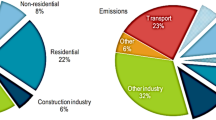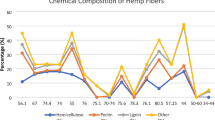Abstract
Innovative building materials are being used in building envelopes for reducing their heating and cooling needs. This paper aims to assess the thermal impact of using lightweight concrete in Lebanese building constructions by pouring an 8 cm thickness of lightweight concrete on the roof and the slab and replacing traditional hollow concrete block by lightweight concrete blocks. Thermal properties of two different samples were experimentally determined: the first one (558 kg/m3) used for the roof and the slab and the second one (1074 kg/m3) used for the walls. Then numerical simulations were carried out for a Lebanese traditional detached house using the characteristics of these two samples. The thermally improved Light Weight Concrete building (LWC) was compared to a traditional Lebanese house base case (BC) using a dynamic building energy simulation tool in the four different Lebanese climate zones: coastal, mid-mountain, mountain, and inland zones. The results highlight the effectiveness of integrating LWC to building envelopes by reducing energy consumption and improving thermal comfort in both winter and summer climate conditions and in the different Lebanese climatic zones. The paper demonstrates that the use of LWC in the vertical walls replacing the traditional hollow blocks can reduce the heating needs by up to 9% and by up to 13% for cooling needs. On the other hand, adding a LWC roof screed has a very high impact on cooling and heating energy consumption, which can reach up to 74% in cooling energy savings and up to 24% in heating energy savings.
Similar content being viewed by others
References
AgriMetSoft (2019). Online Calculators. Available at https://agrimetsoft.com/calculators/Nash%20Sutcliffe%20model%20Efficiency%20coefficient
ALMEE (2010). Thermal Standards for Buildings in Lebanon TSBL. Chen Y, Hong T, Luo X (2018). An agent-based stochastic Occupancy Simulator. Building Simulation, 11: 37–49.
Cherif Y, Joulin A, Zalewski L, et al. (2009). Superficial heat transfer by forced convection and radiation in a horizontal channel. International Journal of Thermal Sciences, 48: 1696–1706.
Cuerda E, Guerra-Santin O, Sendra JJ, et al. (2019). Comparing the impact of presence patterns on energy demand in residential buildings using measured data and simulation models. Building Simulation, 12: 985–998.
Dong B, Yan D, Li Z, et al. (2018). Modeling occupancy and behavior for better building design and operation—A critical review. Building Simulation, 11: 899–921.
Duanmu L, Yuan P, Wang Z, et al. (2017). Heat transfer model of hot-wall Kang based on the non-uniform Kang surface temperature in Chinese rural residences. Building Simulation, 10: 145–163.
Hansen TK, Bjarløv SP, Peuhkuri RH, et al. (2018). Long term in situ measurements of hygrothermal conditions at critical points in four cases of internally insulated historic solid masonry walls. Energy and Buildings, 172: 235–248.
Hou L, Li J, Lu Z, et al. (2019). Effect of nanoparticles on foaming agent and the foamed concrete. Construction and Building Materials, 227: 116698.
Kinab E, Elkhoury M (2012). Renewable energy use in Lebanon: Barriers and solutions. Renewable and Sustainable Energy Reviews, 16: 4422–4431.
Knarud JI, Geving S (2017). Comparative study of hygrothermal simulations of a masonry wall. Energy Procedia, 132: 771–776.
Kumar NV, Arunkumar C, Senthil SS (2018). Experimental study on mechanical and thermal behavior of foamed concrete. Materials Today: Proceedings, 5: 8753–8760.
Leclercq D, Thery P (1983). Apparatus for simultaneous temperature and heat-flow measurements under transient conditions. Review of Scientific Instruments, 54: 374–380.
Lefebvre J (1986). Mesure des débits et des vitesses des fluides (Ed). Paris: Masson. (in French)
Li J, Cao W, Chen G (2015). The heat transfer coefficient of new construction—Brick masonry with fly ash blocks. Energy, 86: 240–246.
Li P, Wu H, Liu Y, et al. (2019). Preparation and optimization of ultralight and thermal insulative aerogel foam concrete. Construction and Building Materials, 205: 529–542.
Li T, Huang F, Zhu J, et al. (2020). Effect of foaming gas and cement type on the thermal conductivity of foamed concrete. Construction and Building Materials, 231: 117197.
Liu S, Zhu K, Cui S, et al. (2018). A novel building material with low thermal conductivity: Rapid synthesis of foam concrete reinforced silica aerogel and energy performance simulation. Energy and Buildings, 177: 385–393.
Miled K, Limam O (2016). Effective thermal conductivity of foam concretes: Homogenization schemes vs experimental data and FEM simulations. Mechanics Research Communications, 76: 96–100.
Ministry of Public Works and Transport General Directorate of Urban Planning (2005). Climatic Zoning for Buildings in Lebanon.
Muroni A, Gaetani I, Hoes PJ, et al. (2019). Occupant behavior in identical residential buildings: A case study for occupancy profiles extraction and application to building performance simulation. Building Simulation, 12: 1047–1061.
Nguyen T, Ghazlan A, Kashani A, et al. (2018). 3D meso-scale modelling of foamed concrete based on X-ray Computed Tomography. Construction and Building Materials, 188: 583–598.
Odgaard T, Bjarløv SP, Rode C (2018). Interior insulation—Characterisation of the historic, solid masonry building segment and analysis of the heat saving potential by 1d, 2d, and 3d simulation. Energy and Buildings, 162: 1–11.
Pak R, Ocak Z, Sorgüven E (2018). Developing a passive house with a double-skin envelope based on energy and airflow performance. Building Simulation, 11: 373–388.
Raj A, Sathyan D, Mini KM (2019). Physical and functional characteristics of foam concrete: A review. Construction and Building Materials, 221: 787–799.
Roberz F, Loonen RCGM, Hoes P, et al. (2017). Ultra-lightweight concrete: Energy and comfort performance evaluation in relation to buildings with low and high thermal mass. Energy and Buildings, 138: 432–442.
RT2012 (2012). French thermal regulation: “Réglementation Thermique 2012”. Available at http://www.rt-batiment.fr/presentation-a12.html
She W, Chen Y, Zhang Y, et al. (2013). Characterization and simulation of microstructure and thermal properties of foamed concrete. Construction and Building Materials, 47: 1278–1291.
She W, Zhang Y, Jones MR (2014). Three-dimensional numerical modeling and simulation of the thermal properties of foamed concrete. Construction and Building Materials, 50: 421–431.
Shen P, Braham W, Yi Y (2018). Development of a lightweight building simulation tool using simplified zone thermal coupling for fast parametric study. Applied Energy, 223: 188–214.
Technical Standard DIN EN 12667 (2001). Thermal performance of building materials and products—Determination of thermal resistance by means of guarded hot plate and heat flow meter methods—Products of high and medium thermal resistance.
World Bank (2009). Energy efficiency study in Lebanon. Econoler international, REF: 5515.
Yoon H-S, Lim T-K, Jeong S-M, et al. (2020). Thermal transfer and moisture resistances of nano-aerogel-embedded foam concrete. Construction and Building Materials, 236: 117575.
Younsi Z, Zalewski L, Lassue S, et al. (2011). A novel technique for experimental thermophysical characterization of phase-change materials. International Journal of Thermophysics, 32: 674–692.
Zalewski L, Lassue S, Rousse D, Boukhalfa K (2010). Experimental and numerical characterization of thermal bridges in prefabricated building walls. Energy Conversion and Management, 51: 2869–2877.
Zhou X, Carmeliet J, Derome D (2018). Influence of envelope properties on interior insulation solutions for masonry walls. Building and Environment, 135: 246–256.
Author information
Authors and Affiliations
Corresponding author
Rights and permissions
About this article
Cite this article
Sassine, E., Kinab, E., Cherif, Y. et al. Thermal performance of lightweight concrete applications in building envelopes in Lebanon. Build. Simul. 14, 1359–1375 (2021). https://doi.org/10.1007/s12273-021-0762-2
Received:
Revised:
Accepted:
Published:
Issue Date:
DOI: https://doi.org/10.1007/s12273-021-0762-2




